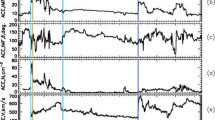Abstract
We report on the statistical analysis of the interaction between coronal mass ejections (CMEs) and streamers based on 15 years (from 1996 to 2010 inclusive) of observation of the solar corona with the LASCO-C2 coronagraph. We used synoptic maps and improved the method of analysis of past investigations by implementing an automatic detection of both CMEs and streamers. We identified five categories of interaction based on photometric and geometric variations between the pre- and post-CME streamers: “brightening”, “dimming”, “emergence”, “disappearance”, and “deviation”. A sixth category, “no change”, included all cases where none of the above variations is observed. A “global set” of 21 242 CMEs was considered as well as a subset of the 10 % brightest CMEs (denoted “top-ten”) and three typical periods of solar activity: minimum, intermediate, and maximum. We found that about half of the global population of CMEs are not associated with streamers, whereas 93 % of the 10 % brightest CMEs are associated. When there is a CME-streamer association, approximately 95 % of the streamers experience a change, either geometric or radiometric. The “no change” category therefore amounts to approximately 5 %, but this percentage varies from 1 – 2 % during minimum to 7 – 8 % during intermediate periods of activity; values of 3 – 5 % are recorded during maximum. Emergences and disappearances of streamers are not dominant processes; they constitute 16 – 17 % of the global set and 23 % (emergence) and 28 % (disappearance) of the “top-ten” set. Streamer deviations are observed for 57 % and 70 % of, respectively, the global set and “top-ten” CMEs. The cases of dimming and brightening are roughly equally present and each case constitutes approximately 30 – 35 % of either set, global or “top-ten”.
















Similar content being viewed by others
References
Antiochos, S.K., DeVore, C.R., Klimchuk, J.A.: 1999, Astrophys. J. 510, 485. doi: 10.1086/306563 .
Boursier, Y., Lamy, P., Llebaria, A., Robelus, S.: 2006, SOHO-17. 10 Years of SOHO and Beyond, ESA SP-617, 119.1 (in CDROM). doi: 10.1007/s11207-009-9370-5 .
Boursier, Y., Lamy, P., Llebaria, A., Goudail, F., Robelus, S.: 2009, Solar Phys. 257, 125. doi: 10.1007/s11207-009-9370-5 .
Brueckner, G.E., Howard, R.A., Koomen, M.J., Korendyke, C.M., Michels, D.J., Moses, J.D., et al.: 1995, Solar Phys. 162, 357. doi: 10.1007/BF00733434 .
Cho, K.S., Bong, S.C., Moon, Y.J., Shanmugaraju, A., Kwon, R.Y., Park, Y.D.: 2011, Astron. Astrophys. 530, 16. doi: 10.1051/0004-6361/201015578 .
Dougherty, E.R.: 1992, An Introduction to Morphological Image Processing, SPIE Optical Engineering Press, Bellingham, 334 – 347.
Floyd, O., Lamy, P., Boursier, Y., Llebaria, A.: 2013, Solar Phys. doi: 10.1007/s11207-013-0281-0 .
Hiei, E., Hundhausen, A.J., Sime, D.G.: 1993, Geophys. Res. Lett. 20, 2785. doi: 10.1029/93GL01449 .
Howard, R.A., Sheeley, N.R. Jr., Michels, D.J., Koomen, M.J.: 1985, J. Geophys. Res. 90, 8173. doi: 10.1029/JA090iA09p08173 .
Hundhausen, A.J.: 1987, In: Pizzo, V.J., Holzer, T., Sime, D.G. (eds.) Proceedings of the Sixth International Solar Wind Conference, NCAR Technical Note NCAR/TN-306 2, 181.
Hundhausen, A.J.: 1993, J. Geophys. Res. 98, 13177. doi: 10.1029/93JA00157 .
Illing, R.M.E., Hundhausen, A.J.: 1986, J. Geophys. Res. 91, 10951. doi: 10.1029/JA091iA10p10951 .
Lamy, P., Llebaria, A., Quemerais, E.: 2002, Adv. Space Res. 29, 373. doi: 10.1016/S0273-1177(01)00599-3 .
Lin, J., Forbes, T.G.: 2000, Bull. Am. Astron. Soc. 32, 842.
Liu, Y.: 2009, In: Lites, B., Cheung, M., Magara, T., Mariska, J., Reeves, K. (eds.) The Second Hinode Science Meeting: Beyond Discovery – Toward Understanding, ASP Conf. Ser. 415, 152.
Llebaria, A., Saez, F., Lamy, P., Robelus, S., Boursier, Y.: 2006, SOHO-17. 10 Years of SOHO and Beyond, ESA SP-617, 135.1 (in CDROM).
Low, B.C.: 1983, In: Stenflo, J.O. (ed.) Solar and Stellar Magnetic Fields: Origins and Coronal Effects, Reidel Publishing Co., Dordrecht, 467.
Low, B.C.: 1996, In: Balasubramaniam, K.S., Keil, S.L., Smartt, R.N. (eds.) Solar Drivers of the Interplanetary and Terrestrial Disturbances, ASP Conf. Ser. 95, 148.
Low, B.C.: 1997, In: Hansteen, V.H. (ed.) Solar Magnetic Fields: Proceedings of a Mini-Workshop, University of Oslo, 1.
Low, B.C.: 2001, J. Geophys. Res. 106, 25141. doi: 10.1029/2000JA004015 .
Luhmann, J.G., Li, Y., Zhao, X., Yashiro, S.: 2003, Solar Phys. 213, 367. doi: 10.1023/A:1023939018916 .
Mancuso, S., Raymond, J.C.: 2004, Astron. Astrophys. 413, 363. doi: 10.1051/0004-6361:20031510 .
McAllister, A.H., Hundhausen, A.J.: 1996, In: Balasubramanian, K.S., Keil, S.L., Smartt, R.N. (eds.) Solar Drivers of the Interplanetary and Terrestrial Disturbances, ASP Conf. Ser. 95, 171.
MacQueen, R.M., Hundhausen, A.J., Conover, C.W.: 1986, J. Geophys. Res. 91, 31. doi: 10.1029/JA091iA01p00031 .
Mikic, Z., Linker, J.A.: 1994, Astrophys. J. 430, 898. doi: 10.1086/174460 .
Odstrcil, D., Pizzo, V.J.: 1999, J. Geophys. Res. 104, 493. doi: 10.1029/1998JA900038 .
Robbrecht, E., Berghmans, D., Van der Linden, R.A.M.: 2009, Astrophys. J. 691, 1222. doi: 10.1088/0004-637X/691/2/1222 .
Saez, F., Llebaria, A., Lamy, P., Vibert, D.: 2007, Astron. Astrophys. 473, 265. doi: 10.1051/0004-6361:20066777 .
Sime, D.G.: 1989, J. Geophys. Res. 94, 151. doi: 10.1029/JA094iA01p00151 .
Subramanian, P., Dere, K.P., Rich, N.B., Howard, R.A.: 1999, J. Geophys. Res. 104, 22321. doi: 10.1029/1999JA900252 .
Wolfson, R., Illing, R.M.E., Conover, C.: 1987, J. Geophys. Res. 92, 13641. doi: 10.1029/JA092iA12p13641 .
Zhao, X., Hoeksema, J.T.: 1996, J. Geophys. Res. 101, 4825. doi: 10.1029/95JA03568 .
Zuccarello, F.P., Bemporad, A., Jacobs, C., Mierla, M., Poedts, S., Zuccarello, F.: 2012, Astrophys. J. 744, 66. doi: 10.1088/0004-637X/744/1/66 .
Acknowledgements
The LASCO-C2 project at the Laboratoire d’Astrophysique de Marseille is funded by the Centre National d’Etudes Spatiales (CNES). LASCO was built by a consortium of the Naval Research Laboratory, USA, the Laboratoire d’Astrophysique de Marseille (formerly Laboratoire d’Astronomie Spatiale), France, the Max-Planck-Institut für Sonnensystemforschung (formerly Max Planck Institute für Aeronomie), Germany, and the School of Physics and Astronomy, University of Birmingham, UK. SOHO is a project of joint collaboration by NASA and ESA.
Author information
Authors and Affiliations
Corresponding author
Rights and permissions
About this article
Cite this article
Floyd, O., Lamy, P. & Llebaria, A. The Interaction Between Coronal Mass Ejections and Streamers: A Statistical View over 15 Years (1996 – 2010). Sol Phys 289, 1313–1339 (2014). https://doi.org/10.1007/s11207-013-0379-4
Received:
Accepted:
Published:
Issue Date:
DOI: https://doi.org/10.1007/s11207-013-0379-4




